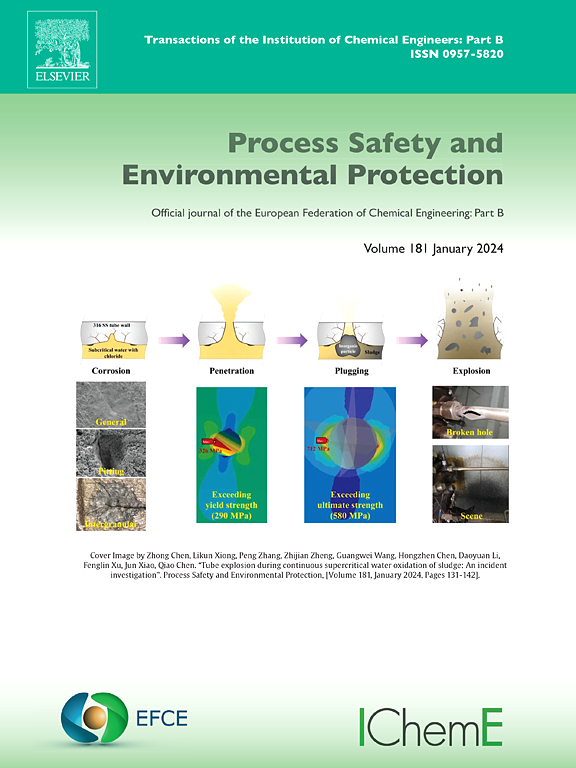Adaptive noise cancellation based on CEEMDAN-LMS for pipeline leak location under low SNR
IF 7.8
2区 环境科学与生态学
Q1 ENGINEERING, CHEMICAL
引用次数: 0
Abstract
To reduce leak localization errors caused by background noise interference, an adaptive noise cancellation method based on the combination of complete ensemble empirical mode decomposition with adaptive noise and LMS filter (CEEMDAN-LMS) is proposed for pipeline leak location. First, the CEEMDAN is used to decompose the detection signal into several intrinsic mode functions (IMFs). To improve the algorithm’s adaptability and accuracy under low signal-to-noise ratio (SNR) conditions, an IMF selection strategy based on the cross-correlation (CC) function between each IMF and another detection signal is proposed. According to this strategy, the IMFs are classified into signal components and noise components. The signal components are then further denoised using an LMS filter. The quality of the reference noise in the LMS filter determines the filtering effectiveness. To obtain high-quality reference noise, this paper proposes a novel reference noise generation method, where selected noise components are summed and then decomposed again using CEEMDAN to create the reference noise. This reference noise is extracted from the original signal, highly correlated with the noise in the original signal, and has a narrow frequency band, which effectively improves the filtering performance. Finally, the filtered signal components are recombined to reconstruct the denoised signal. The time delay of the denoised signal is estimated using the CC function to pinpoint the leak location. In the simulation, two detection signals with initial SNRs of −18 dB were processed by CEEMDAN, resulting in improvements of 9.54 dB and 9.09 dB, respectively. After further processing with the LMS filter, the improvements were 1.9 dB and 1.97 dB, respectively. In real experiments, the localization error using direct CC of the unprocessed signal was 10.85 %, while the error after CEEMDAN-LMS processing was reduced to 2.99 %, showing a significant improvement in localization accuracy.
基于CEEMDAN-LMS的低信噪比管道泄漏定位自适应降噪方法
为了降低背景噪声干扰引起的泄漏定位误差,提出了一种基于全系综经验模态分解与自适应噪声和LMS滤波器相结合的管道泄漏定位自适应噪声消除方法(CEEMDAN-LMS)。首先,利用CEEMDAN将检测信号分解为若干个内禀模态函数(IMFs)。为了提高算法在低信噪比(SNR)条件下的适应性和准确性,提出了一种基于每个IMF与另一个检测信号之间互相关函数的IMF选择策略。根据这一策略,imf被分为信号分量和噪声分量。然后使用LMS滤波器进一步对信号分量进行降噪。LMS滤波器中参考噪声的质量决定了滤波效果。为了获得高质量的参考噪声,本文提出了一种新的参考噪声生成方法,该方法将选定的噪声分量进行求和,然后使用CEEMDAN进行分解,生成参考噪声。该参考噪声是从原始信号中提取出来的,与原始信号中的噪声高度相关,且频带较窄,有效提高了滤波性能。最后,对滤波后的信号分量进行重组,重建去噪后的信号。使用CC函数估计去噪信号的时间延迟,以确定泄漏位置。仿真中,CEEMDAN对初始信噪比为−18 dB的两个检测信号进行处理,分别提高了9.54 dB和9.09 dB。经LMS滤波器进一步处理后,改进幅度分别为1.9 dB和1.97 dB。在实际实验中,对未处理信号直接CC的定位误差为10.85 %,而CEEMDAN-LMS处理后的定位误差降至2.99 %,定位精度显著提高。
本文章由计算机程序翻译,如有差异,请以英文原文为准。
求助全文
约1分钟内获得全文
求助全文
来源期刊

Process Safety and Environmental Protection
环境科学-工程:化工
CiteScore
11.40
自引率
15.40%
发文量
929
审稿时长
8.0 months
期刊介绍:
The Process Safety and Environmental Protection (PSEP) journal is a leading international publication that focuses on the publication of high-quality, original research papers in the field of engineering, specifically those related to the safety of industrial processes and environmental protection. The journal encourages submissions that present new developments in safety and environmental aspects, particularly those that show how research findings can be applied in process engineering design and practice.
PSEP is particularly interested in research that brings fresh perspectives to established engineering principles, identifies unsolved problems, or suggests directions for future research. The journal also values contributions that push the boundaries of traditional engineering and welcomes multidisciplinary papers.
PSEP's articles are abstracted and indexed by a range of databases and services, which helps to ensure that the journal's research is accessible and recognized in the academic and professional communities. These databases include ANTE, Chemical Abstracts, Chemical Hazards in Industry, Current Contents, Elsevier Engineering Information database, Pascal Francis, Web of Science, Scopus, Engineering Information Database EnCompass LIT (Elsevier), and INSPEC. This wide coverage facilitates the dissemination of the journal's content to a global audience interested in process safety and environmental engineering.
 求助内容:
求助内容: 应助结果提醒方式:
应助结果提醒方式:


